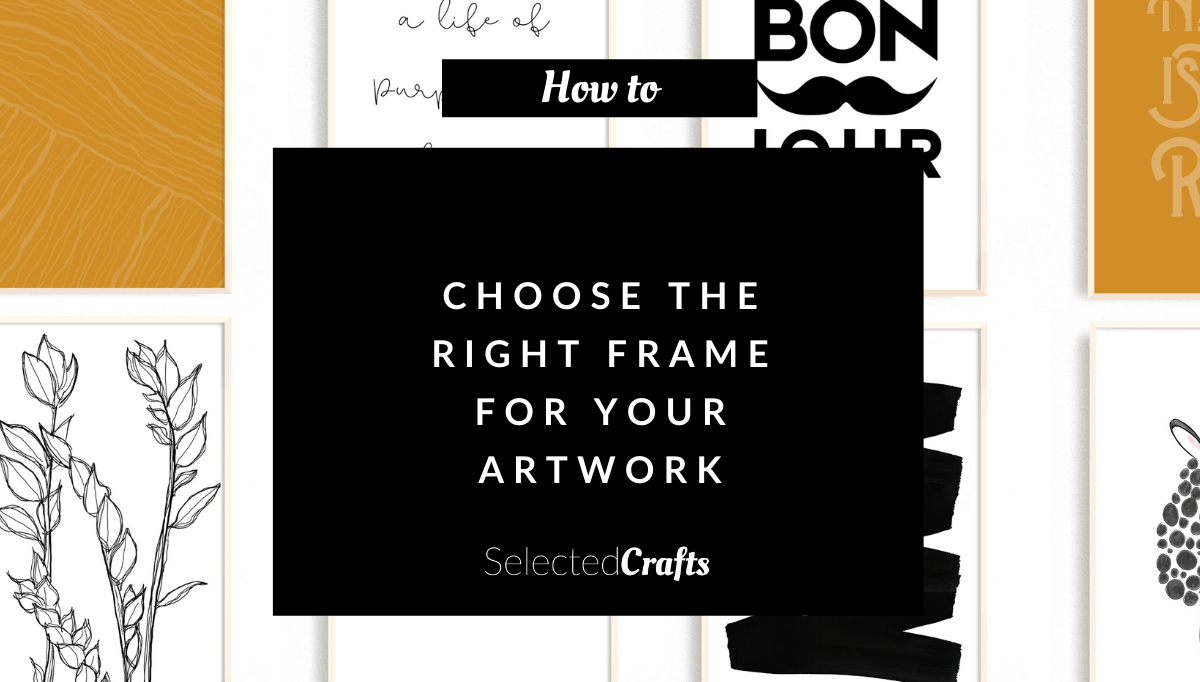There are a lot of ways to frame your art. As a beginner art collector, it can be difficult to know what framing options you have. In this blog post, we will address this and have look at how to choose the right frame for your artwork.
You can find frames at your local art dealer, home decor shops, or online. Personally, I prefer to shop frames second hand. You could even DIY frames and make your own design. Hopefully, you can find a framing option that suits you. In this blog post, we look at how to choose the right frame type, style, size, and position.
Choose the correct frame type
When I talk about a frame type, I refer to the structure of the frame. There are endless options when choosing materials and styling for a frame but in general, there are few groups of frames.
- Frames with a border and covered with glass
- Frames without a border but covered with glass
- Frames with two sides of glass, transparent frames.
- Open frames without glass
- Digital frame
- Poster Hangers
Whichever frame type you choose you should always aim for the same thing, to frame your art for a lifetime. This can be tricky because not all types of art require the same kind of protection.
For example, the best way to protect drawings and watercolors is by framing them in a frame covered by glass or acrylic. This will protect it from wear and tear and prolong the lifespan of the artwork. Both glass and acrylic protect the art from dust and dirt, but some acrylic-covered frames also have built-in UV-protection.
Other kinds of art like oil and acrylic are usually sturdy and don’t require any extra protection. They can actually get damaged by being squeezed into a covered frame. These art types it is better off in an open frame that simply complements the art. Most paintings are painted on standard-sized canvases which makes it easy to find frames for them. Please keep in mind that oil and acrylic paintings require occasional maintenance. You should dust your paintings gently with a feather duster, never clean a painting. Never use cleaning products or damp cloths on your paintings.
Frames can be costly, not everyone has the budget to invest in brand new frames for every artwork in their home. Luckily there are many other options to consider like buying frames second hand or DIY’ing your frames.
It is also very likely that you prefer to display your art in a certain way. Maybe that’s without a frame altogether. That is fine! As long as you remember that the way you frame your art affects the lifespan of your art.
Choosing a frame a style
There are not of different styles of frames, from covered in gold antiques to wood and metal. You can have frames that are just a transparent glass cover. Some frames have additional sculptural or decorative features and some are very minimal. Which style you go for is entirely based on your preferences. A ground rule is to choose a frame based on artwork, not the other way around. You want to find a frame that provides a decent amount of contrast, without overpowering or blending into the artwork. When settling for colors or materials for your frame, a piece of general advice is to choose something that ties the artwork to the rest of your home decor.
With that said, there is nothing that says that you can’t combine a certain motive or technique with a frame in clashing color or material. This usually only creates intrigue.
Another tip for creating intrigue is to go for a frame in an unusual shape like for example round or triangular. You don’t see that type of frame all too often but they are beautiful features in gallery walls for example.
However, I would never separate a collector painting from its original frame for example.
Choosing the right frame size
The most common scenario is that you order a frame in the same size as your artwork. But this does not have to be the case. You can absolutely go for a frame that is bigger than the actual artwork. Then you would usually use a frame with a white or black backing, but there are no rules. Transparent frames or frames with both a glas front and back have become very popular.
Going for a bigger frame is actually a really handy design hack. Especially if you have fallen in love with a small art piece. The size of the frame will help to give the art more impact by drawing the eye to the artwork.
For certain artworks, you might want to use a cardboard mount or edge around your art. These are very common and are called Passepartout. They can both be used to highlight the print in terms of creating a contrasting trim.
You can also use a method called floating, which is when you attach a cardboard or foam spacer behind your artwork. This creates some depth between the mount of the frame and the artwork, that 3D effect is called footing.
In most cases, you want to be careful to choose the right size. For example with poster hangers, it is very important that you get the size right. Otherwise, the art might look very misplaced.
Frame positioning
The first thing when positioning your art is the size, usually smaller artworks, and photographs can be placed on tabletops and it usually makes sense to hang larger artworks on the wall. A general rule when positioning your artwork on a wall is to hang it at eye height.
Depending on which type of art you have you should also consider if the artwork will be damaged in direct sunlight or not. Art, just like plants, have different needs.
Usually, the positioning of an artwork is not a big issue since most of us shop based on the available space. One challenging thing can be to make your art look good in an arrangement.
If you want to learn how to build a gallery wall, check out my free ebook with a step-by-step guide!
If investing in artwork and frames feels like too much fuzz. Then check out this blog post to see if a digital art frame is a better option for you!
Please let me know if you agree with the things I have pointed out!
Make sure to become an email insider to get updates when I create more juicy content like this!


